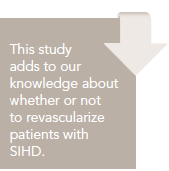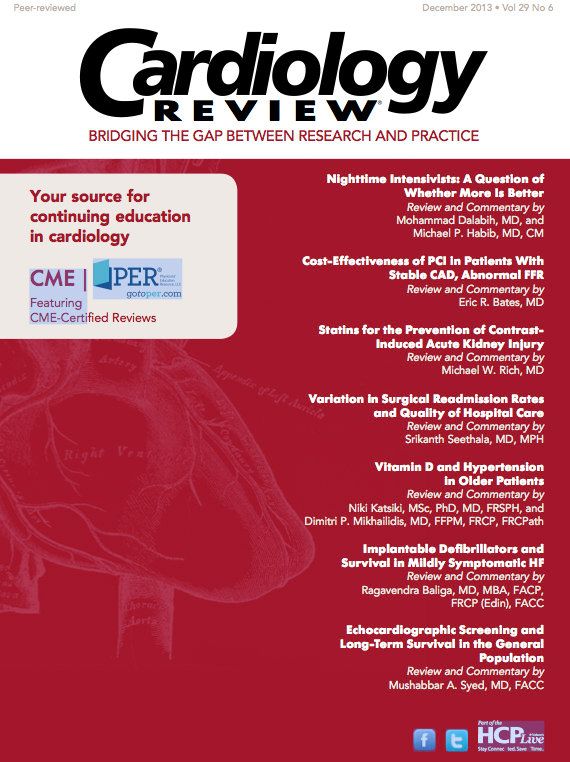Publication
Article
Cardiology Review® Online
Cost-Effectiveness of PCI in Patients With Stable CAD, Abnormal FFR
Author(s):

Eric R. Bates, MD
Review
Fearon WF, Shilane D, Pijls NHJ, et al. Cost-effectiveness of percutaneous coronary intervention in patients with stable coronary artery disease and abnormal fractional flow reserve. Circulation. 2013;128:1335-1340.

The Fractional Flow Reserve versus Angiography for Multivessel Evaluation 2 (FAME-2) trial was a prospective, multicenter, open-label randomized trial in patients with single or multivessel stable ischemic heart disease (SIHD) and a fractional flow reserve (FFR) ≤0.08 across 1 or more stenosis.1 Patients were randomized to percutaneous coronary intervention (PCI) with second-generation drug-eluting stents plus best medical therapy or best medical therapy alone. The primary composite end point was death from any cause, nonfatal myocardial infarction (MI), or unplanned hospitalization leading to urgent revascularization during the first 2 years.
The trial was powered at 84% to include 1632 patients by estimating that the primary end point at 24 months would occur in 12.6% in the PCI group and 18.0% in the medical therapy group. No formal rules concerning halting the trial were specified in the protocol. Nevertheless, only 888 patients were randomized before the study was prematurely terminated, and follow-up was only a mean of 213 days. The primary outcome occurred in 4.3% of the 447 patients randomized to PCI and in 12.7% of the 441 patients randomized to medical therapy (P <.001). It is important to note that there were no differences in death (0.2% vs 0.7%) or MI (3.4% vs 3.2%); the difference was in the rate of urgent revascularization (1.6% vs 11.1%; P <.001). Only 75 patients experienced an end point event: death, 1 (PCI) versus 3 (medical therapy); MI, 15 (PCI) versus 14 (medical therapy); and urgent revascularization, 7 (PCI) versus 49 (medical therapy).
It is not clear why the Data Safety Monitoring Board (DSMB) was concerned about the study results or why the Steering Committee accepted the DSMB recommendation to halt the trial prematurely when there were no differences in death or MI rates. Premature termination and incomplete follow-up in a randomized trial usually results in overestimation of the treatment effect and limits the value of the trial to the study volunteers, the investigators, and the scientific community. The “urgent” need for revascularization in the FAME-2 trial, not seen in other trials of SIHD, suggests that patients who perhaps should have undergone initial PCI for more significant symptoms or more severe stenoses were randomized to an inferior treatment with initial medical therapy because of participation in the trial and then crossed over to PCI because of uncontrolled symptoms. Equipoise in treatment options is supposed to be present before randomization. In fact, more than 50% of the lesions were >70% diameter stenosis and 14% were >90% diameter stenosis, and almost 25% of the patients had Canadian Cardiovascular Society (CCS) Class III/IV angina. The open-label design and investigator awareness of lesion percentage diameter stenosis may also have influenced the decision to cross over to PCI after initial medical therapy.
In the FAME-2 cost-effectiveness report, 12-month medical costs were calculated.2 Angina, number and doses of cardiac medications, employment status, and patient utility assessed by the European Quality of Life-5 Dimensions (EQ-5D) instrument were also determined. Patients undergoing PCI, not surprisingly, experienced less angina at 30 days (11.1% vs 28.9%), but there was no effect on employment status. The initial ($6027) and 1-year follow-up ($2883) cost differences were greater with the initial PCI strategy. The incremental costeffectiveness ratio (ICER) was $36,000 per quality-adjusted life-year (QALY), below the willingness-to-pay threshold of $50,000/QALY. However, the ICER was $102,000/QALY for CCS class 0/1 angina compared with $26,000/QALY with class 2-4 angina.
Because only 11% of patients provided 12-month EQ-5D scores, baseline and 1-month scores were used to determine QALY. Similarly, extrapolations were necessary to compute 12-month costs because the median follow-up was only 7 months.
CommentaryTo Vascularize or Not to Revascularize SIHD Patients
There is a long-standing debate about whether or not to revascularize patients with SIHD. The traditional cardiology paradigm that myocardial ischemia predicts major adverse cardiac events has been used to promote a diagnostic strategy of exercise testing and cardiac catheterization, and a therapeutic strategy of revascularization with PCI or coronary artery bypass graft surgery (CABG) to improve prognosis. Unfortunately, this excellent theory has yet to be proved in randomized clinical trials.3
Most recently, the Clinical Outcomes Utilizing Revascularization and Aggressive Drug Evaluation (COURAGE)4 and Bypass Angioplasty Revascularization Investigation 2 Diabetes (BARI-2D)5 trials have again suggested that patients with SIHD can start with medical treatment and then undergo elective revascularization only if they or their physicians are not satisfied with symptom control, with no increased risk of death or MI expected from delaying the decision on revascularization until an initial trial of best medical therapy has been tried, and low risk for urgent revascularization. Evidence-based guidelines, based on these and other studies, continue to recommend this strategy.6,7
PCI has become a very effective, relatively simple, low-risk procedure for treating myocardial ischemia due to focal coronary artery stenoses when revascularization is indicated. Recent criticism about the overuse of PCI in patients with SIHD has emphasized that ischemia is not documented in the majority of patients and that intermediate stenoses that might not cause ischemia are being stented because of the “oculo-stenotic reflex.” FFR is a pressure wire—based index that measures the physiologic significance of a coronary stenosis during cardiac catheterization. When the ratio between distal pressure and aortic pressure during maximal coronary vasodilation becomes ≤0.8, downstream perfusion is limited and may become inadequate when myocardial oxygen demand increases, resulting in myocardial ischemia.
Three randomized clinical trials have evaluated the clinical utility of FFR. To determine the safety of deferring PCI on a stenosis with a normal FFR, the Deferral of Percutaneous Coronary Intervention (DEFER) trial randomized 181 patients with SIHD and FFR ≥0.75 across an intermediate stenosis to PCI or medical treatment.8 At 5-year follow-up, the deferred group had a lower rate of death or MI than the PCI group (3.3% vs 7.9%), supporting the safety of medical therapy for SIHD in the absence of documented myocardial ischemia.
To evaluate the utility of FFR in selecting patients for PCI, the Fractional Flow Reserve versus Angiography for Multivessel Evaluation (FAME) trial randomized 1005 patients with multivessel disease (including SIHD, unstable angina, and non-ST elevation MI [NSTEMI]) to either FFR-guided or angiography-guided PCI.9 The primary composite end point of death, MI, or repeat revascularization at 1 year was significantly lower (13.2% vs 18.3%) in patients who received FFR-guided PCI. An economic evaluation demonstrated that FFR-guided PCI was a cost-saving strategy ($2300 per patient) at 1 year, with fewer stents deployed.10
To compare outcomes in FFR-guided PCI with medical therapy, the Fractional Flow Reserve versus Angiography for Multivessel Evaluation 2 (FAME 2) trial randomized 888 patients with single or multivessel SIHD to FFR-guided PCI with best medical therapy or best medical therapy alone.1 All stenoses were assessed by FFR; patients had to have at least 1 lesion with FFR ≤0.80. FFR-guided therapy decreased the need for urgent revascularization and was cost-effective.1,2
The FAME-2 study showed reduced angina burden and good value for PCI ($36,000/QALY) in patients with documented ischemia. 2 In contrast, the COURAGE economic analysis suggested lack of cost-effectiveness for PCI (≥$168,000/QALY).11,12 An important difference between trials is that the primary end point in COURAGE was death/MI, whereas the primary end point in FAME-2 was death/MI/urgent revascularization. Patients in FAME-2 had higher rates of angina and a higher rate of hospitalization for acute coronary syndromes and for revascularization than the patients in COURAGE.
Both studies agree that there is no difference in death or MI rates whether one uses physiologic or angiographic criteria to select patients for PCI. The difference with medical therapy as an initial strategy is that there will be more subsequent PCI procedures, but fewer total PCI procedures—an attractive option for the future, when accountable care organizations (ACOs) will have a fixed budget for treating SIHD. For instance, in FAME-2, subsequent revascularization was required in 14 patients in the initial PCI group versus 86 patients in the best medical therapy group, an advantage the authors claim in favor of an initial PCI strategy. However, the total number of revascularization procedures was 461 in the PCI group and 86 in the medical therapy group.
FAME and FAME-2 support the concept that revascularization for ischemia is reasonable, but do not prove superiority of FFRguided versus angiography-guided decision making. FFR is most useful when the indications for PCI are ambiguous based on noninvasive testing and coronary angiography or when noninvasive testing is absent, equivocal, or does not provide objective evidence of ischemia in the myocardial territory perfused by the index artery.13 The PCI practice guidelines already give a class I indication for PCI in patients with ≥70% diameter stenosis and unacceptable angina on guideline-directed medical therapy.6 It is PCI in the 50% to 70% diameter stenosis that requires demonstration of ischemia by stress testing or FFR to meet appropriate use criteria.14 It is important to note that FFR is another piece of information for decision making, not a mandate to perform PCI. It still is unclear whether myocardial ischemia is a strong predictor of subsequent cardiac events. This hypothesis is being further evaluated in the International Study of Comparative Health Effectiveness with Medical and Invasive Approaches (ISCHEMIA) trial (ClinicalTrials. gov, NCT01471522).
References
1. De Bruyne B, Pijls NH, Kalesan B, et al. Fractional flow reserve-guided PCI versus medical therapy in stable coronary disease. N Engl J Med. 2012;367:991-1001.
2. Fearon WF, Shilane D, Pijls NH, et al. Cost-effectiveness of percutaneous coronary intervention in patients with stable coronary artery disease and abnormal fractional flow reserve. Circulation. 2013;128:1335-1340.
3. Pursnani S, Korley F, Gopaul R, et al. Percutaneous coronary intervention versus optimal medical therapy in stable coronary artery disease: a systematic review and meta-analysis of randomized clinical trials. Circ Cardiovasc Interv. 2012;5:476-490.
4. Boden WE, O’Rourke RA, Teo KK, et al. Optimal medical therapy with or without PCI for stable coronary disease. N Engl J Med. 2007;356:1503- 1516.
5. The BARI 2D Study Group. A randomized trial of therapies for type 2 diabetes and coronary artery disease. N Engl J Med. 2009;360:2503-2515.
6. Fihn SD, Gardin JM, Abrams J, et al. 2012 ACCF/AHA/ACP/AATS/ PCNA/SCAI/STS Guideline for the diagnosis and management of patients with stable ischemic heart disease. J Am Coll Cardiol. 2012;60:e44-e164.
7. Montalescot G, Sechtem U, Achenbach S, et al. 2013 ESC guidelines on the management of stable coronary artery disease. Eur Heart J. 2013;34:2949-3003.
8. Pijls NH, van Schaardenburgh P, Manoharan G, et al. Percutaneous coronary intervention of functionally nonsignificant stenosis: 5-year followup of the DEFER Study. J Am Coll Cardiol. 2007;49:2105-2111.
9. Tonino PA, De Bruyne B, Pijls NH, et al. Fractional flow reserve versus angiography for guiding percutaneous coronary intervention. N Engl J Med. 2009;360:213-224.
10. Fearon WF, Bornschein B, Tonino PA, et al. Economic evaluation of fractional flow reserve-guided percutaneous coronary intervention in patients with multivessel disease. Circulation. 2010;122:2545-2550.
11. Weintraub WS, Spertus JA, Kolm P, et al. Effect of PCI on quality of life in patients with stable coronary disease. N Engl J Med. 2008;359:677-687.
12. Weintraub WS, Boden WE, Zhang Z, et al. Cost-effectiveness of percutaneous coronary intervention in optimally treated stable coronary patients. Circ Cardiovasc Qual Outcomes. 2008;1:12-20.
13. Lotfi A, Jeremias A, Fearon WF, et al. Expert consensus statement on the use of fractional flow reserve, intravascular ultrasound, and optical coherence tomography: a consensus statement of the society of cardiovascular angiography and interventions [published online ahead of print October 6, 2013]. Catheter Cardiovasc Interv. doi:10.1002/ccd.25222.
14. Patel MR, Dehmer GJ, Hirshfeld JW, Smith PK, Spertus JA. ACCF/ SCAI/STS/AATS/AHA/ASNC 2009 Appropriateness Criteria for Coronary Revascularization. Circulation. 2009;119:1330-1352.
About the Author
Eric R. Bates, MD, is Professor of Internal Medicine at the University of Michigan. Dr. Bates graduated from the University of Michigan Medical School, where he trained in internal medicine and cardiology. His research efforts have focused on fibrinolytic and catheter-based reperfusion therapy for acute MI and cardiogenic shock, antiplatelet and anticoagulant therapy for coronary thrombosis, and coronary artery revascularization. He was vice-chair for the 2011 ACCF/AHA Guidelines for Percutaneous Coronary Intervention Writing Committee. He is also Chair of the Mission: Lifeline Science Task Force.






